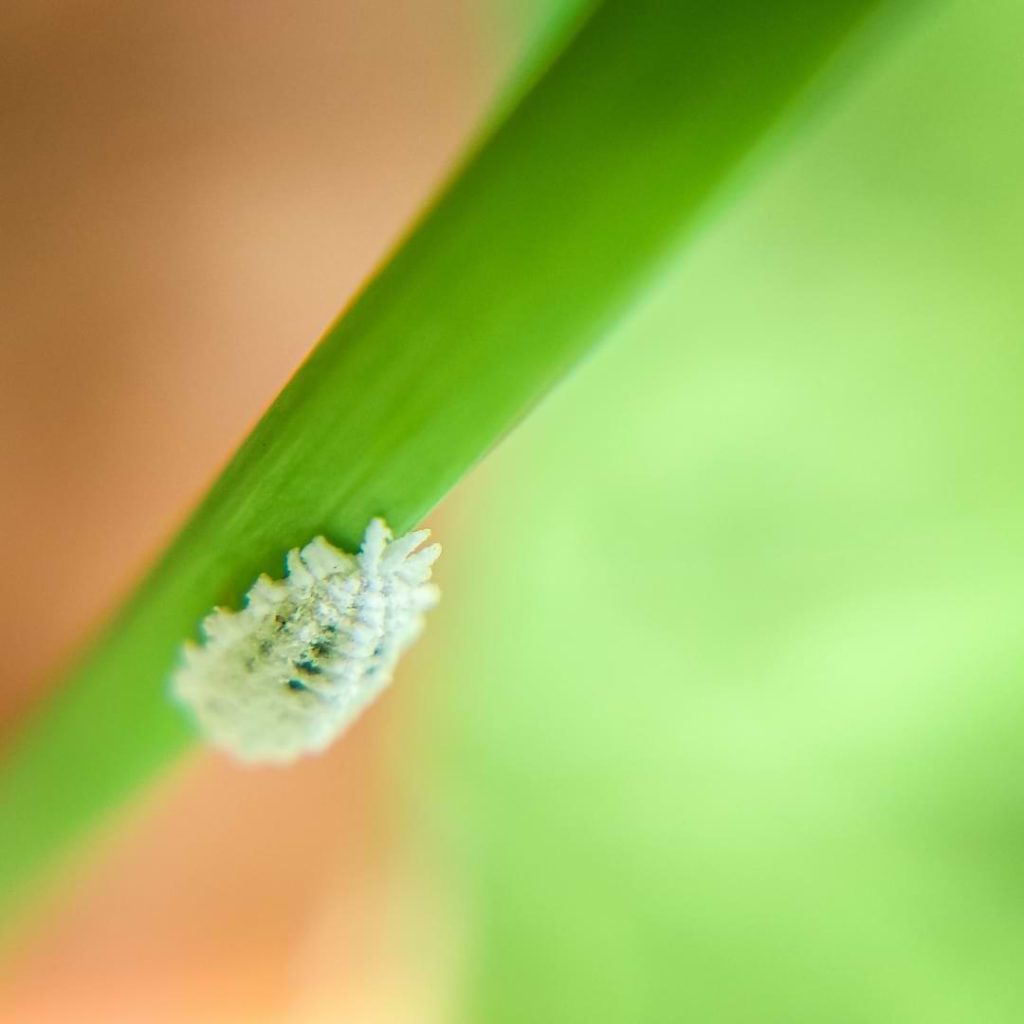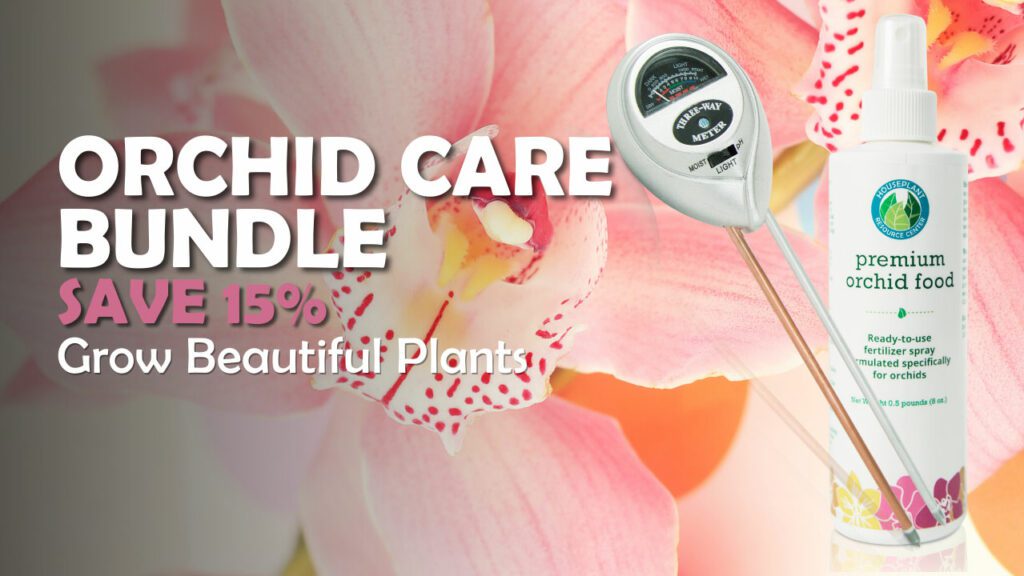Finding pests on your orchids is never fun. Mealybugs, especially, are the last thing you want to see on your gorgeous plants. These tiny bugs can be incredibly difficult to get rid of and can quickly cause a lot of damage to your houseplants.
Even though mealybugs are difficult to handle, seeing a mealybug on your orchid doesn’t have to be a disaster. There are steps you can take to eliminate mealybugs as soon as you spot them allowing you to protect your orchid from further damage.
Mealybugs suck the sap from plants, which weakens them and eventually leads to death if left untreated. Besides weakening orchids, mealybugs produce a substance known as honeydew, which attracts ants and can also create conditions for sooty mold to form on the plant. Basically, you don’t want mealybugs anywhere near your prized orchids.
Keep reading to learn how to prevent mealybug infestations in the first place and what to do to get rid of mealybugs if you find them on your orchids.
How to Identify Mealybugs
Mealybugs are tropical insects, which is why they are so drawn to your orchids. These insects have soft bodies and typically grow to be 1/20 to ⅕ of an inch in size. Mealybugs are pink, but due to the wax that covers them, they may appear white, yellowish-white, pale pink, or even pale blue. Mealybugs are related to scale, but unlike scale, mealybugs have legs. One of the most common types of mealybugs is the longtailed mealybug, which is easy to recognize because of its long filaments sticking off the end of its body.
You’ll normally find mealybugs on roots, rhizomes, and the undersides of leaves, however, they can be found on any part of a plant. Sometimes they even leave plants looking for more food, so check around the edges of pots and containers. Even though mealybugs like tropical plants, they may feed on other houseplants as well, so it’s important to check all your plants if you find mealybugs on any plant. It’s possible to find mealybugs hiding in the soil, but this is more common with African violets than with orchids.
The most common symptoms of mealybug damage are stunted growth, loss of foliage, wilting, and yellow leaves. You may also notice large numbers of small yellow eggs laid together in a mass resembling cotton.
Mealybug Life Cycle
Mealybugs appear differently during each of the three stages of their life cycles. Here’s a quick overview so you know what to look for:
- Eggs: Mealybugs start out as eggs. Female mealybugs lay a waxy egg sack containing hundreds of eggs. Sometimes these egg sacks have a cotton-like appearance. The eggs usually hatch after 10 days. Long-tailed mealybugs are the exception, which have live young rather than eggs.
- Nymphs: During the middle of its lifecycle, mealybugs are known as nymphs, which look like tiny versions of adult mealybugs. This is actually the stage when mealybugs are most active. Although they will still crawl around as adults, they do most of their crawling between plants during this stage.
- Adults: Adult mealybugs are not as active as nymphs, but they will still move around to find food sources. Female adults lay eggs for 5 to 10 days before the end of their life cycle.
During the mealybug life cycle, the males are not as active. They create a cocoon during the nymph stage and only live for a few days during the adult stage. You’re much more likely to see the female mealybugs than the males.
For reference, new generations appear more frequently when the temperature is moderate. High temperatures slow things down a little.
How to Get Rid of Mealybugs
The best way to deal with mealybugs is to keep them away from your orchids in the first place; however, this isn’t always possible. Once you find mealybugs on your plants, it’s time to take action. Even though the process isn’t exactly fun, it is possible to get rid of mealybugs.
If you notice mealybugs before they have a chance to infest your orchids, you will have fewer problems getting rid of them. Start with less intensive methods and work your way up as needed.
Mealybugs have a short life cycle and the generations can overlap, so plan to treat the problem every 10-14 days to successfully stop a mealybug infestation. For a severe infestation, you will most likely need to use insecticide.
Here are the different options and how to use them.
Rubbing Alcohol
The use of rubbing alcohol, also known as isopropyl alcohol, is the most common first resort against mealybugs. Use a cotton swab or cotton ball dipped in rubbing alcohol to rub over all parts of the plant.
Remove mealybugs as you find them, and be sure to get into all the tiny folds and creases of the plant. You will also need a spray bottle to get into areas that you cannot reach with the cotton swab.
Some orchid owners mix liquid dish detergent or oils with the rubbing alcohol. While you can try this, 70% isopropyl alcohol will work without any additions. Alcohol will not kill all the eggs, so you’ll need to repeat the process within 10-14 days to stop the new mealybug generation.
Repotting
As mentioned above, mealybugs sometimes hide in the soil where they can feed off the roots. Changing the potting soil will help ensure you get rid of all mealybugs. Dispose of the potting soil, and repot with a clean container and fresh soil.
Inspect the roots carefully when repotting. If there are signs of mealybugs on the roots, clean the roots gently to prevent contaminating the new soil.
Neem Oil
Neem oil as well as horticultural oils and mineral oil can be used to smother mealybugs. You’ll need to spray every area of the orchid to ensure you get all mealybugs. Be sure to repeat the process in 10-14 days because it will not kill every stage of the mealybug.
After applying the oil, keep the orchid out of direct sunlight until the oil dries. Most orchids aren’t in direct sun, but the leaves will burn more easily until the oil is dry.
Another product to try is our Leaf Armor Spray, which not only protects your plants from bugs and bacteria, but also keeps your plant’s leaves looking shiny and vibrant!
Diatomaceous Earth
Diatomaceous earth is a substance that dehydrates pests when they come into contact with it, and the pests eventually die as a result. The benefit of diatomaceous earth is that the substance does not harm humans or household animals; however, this method works slowly, and it only kills mealybugs that come into contact with it. The substance has no effect on eggs until the insects have hatched.
Sprinkling diatomaceous earth on the soil and on your orchid can help eliminate a light mealybug infestation. Diatomaceous earth only works as long as it remains dry; once it gets wet, you’ll need to replace the diatomaceous earth.
Soap and Water
Some people use a homemade spray with dish soap and water to get rid of mealybugs. The soap works to suffocate the mealybugs, but it only works on nymph and adult mealybugs, so be sure to reapply within 10-14 days to get rid of all pests.
Combine one teaspoon of dish soap with one quart of water to make the spray. Before using the spray on the entire orchid, test it on a portion of one leaf and wait a couple of days before spraying the rest of the plant. Some dish soaps have an adverse effect on orchids, and they can differ depending on the orchid type.
For light mealybug infestations, the use of a soap and water spray can be effective.
Insecticides
Commercial insecticides can be more effective at eliminating mealybugs than home remedies. However, they can also damage plants or even be dangerous for people and animals in your home.
Only use insecticide for ornamental plants on your orchids. Pay careful attention to the labels and follow the instructions—do not use more than the recommended amount. You should apply insecticides outdoors when possible. If you can’t apply the insecticide outdoors due to weather, spray your plant inside a plastic bag or cardboard box and then allow the plant to air out in an area that won’t allow fumes to spread around your home.
Growth Regulators and Chitin Inhibitors
Insect growth regulators and chitin inhibitors control mealybug infestations by disrupting the insects’ hormones and their life cycle. These substances don’t kill mealybugs on contact, but they do cause the insects to die before they’re mature enough to reproduce.
Because mealybug generations overlap, you’ll have to apply growth regulators and chitin inhibitors more than once to get rid of all pests. It’s important to follow all label instructions in order to eradicate the mealybugs on your orchids. Since these substances kill mealybugs slowly, the damage to your orchid won’t stop immediately, but this method can be an effective solution to allow you to get rid of an entire mealybug population over time.
Biological Control
Biological control is a great way to keep mealybugs in check. Unfortunately, it doesn’t work indoors, so it’s not an effective way for home orchid owners to keep mealybugs away from their orchids.
Biological control works by encouraging parasitic wasps and other insects to feed on mealybugs. It won’t completely stop mealybugs, but it does keep the population manageable. This method might be useful if you have a large greenhouse where you keep your orchids and other plants, but for those of us with indoor plants, biological control won’t help get rid of mealybugs.
How to Prevent Mealybugs
As you can see, there are no easy methods to instantly get rid of all mealybugs. Sometimes infestations can keep recurring for months. For this reason, preventing mealybugs is less of a hassle than dealing with them once they’re in your home.
Here are some precautions to reduce your risk of having a mealybug problem in the first place:
- Only get orchids from reputable, quality sources. Good orchid growers will take steps to prevent selling orchids that are infested with mealybugs. This means you’ll be less likely to bring an orchid home that has mealybugs hitching a ride.
- Inspect plants before bringing them into your home. Take a close look at any plants you purchase or are given. If you see signs of mealybugs, don’t keep the plant. Reputable sellers will allow returns of infected plants, and even if you can’t return a plant, losing one plant is better than dealing with months of infestation.
- Avoid moving plants back and forth between indoors and outdoors. While most of us aren’t bringing our orchids outside at all, there is a chance any plants that are outdoors for any length of time can attract mealybugs. If you have any houseplants that you place outdoors in the summer, inspect them carefully before bringing them back inside. Remember, mealybugs can spread easily from one plant to another.
Final Thoughts
Even with the best precautions, it’s still possible to accidentally introduce mealybugs into your home. Inspect your plants each time you water them for signs of mealybugs. If you catch an infestation early, it’s much easier to treat. If you isolate the infected plant right away, you might not have any other plants be affected.
Mealybugs are one of the most damaging pests that affect houseplants, so knowing what to look for and how to treat them can help you keep your orchids happy and healthy. Hopefully you never have to deal with mealybugs, but if you do, you now know several strategies to try.
It’s never fun to deal with mealybugs, but if you are able to eradicate the pests, then your orchid will recover and you’ll continue enjoying it for a long time to come.
Join Our Orchid Care Facebook Community
In our Facebook group of orchid lovers, we’re dedicated to creating a rich and engaging environment where plant lovers can come together and share tips, tricks, and experiences.
If you’re an orchid lover, come join our Facebook community! We can’t wait to celebrate your successes and help you troubleshoot your care routine.
For continued success, you can explore our other articles or visit our online shop for plant care products that are sure to keep your plants boasting rich green leaves and big, bountiful blooms year-round.



